#E. Gary Gygax
Text
« Game Wizards », de Jon Peterson
Aujourd'hui sur Blog à part – « Game Wizards », de Jon Peterson
Décidément, on aura beaucoup parlé jeu de rôle sur le blog, cette semaine. Aujourd’hui, c’est Game Wizards, le dernier ouvrage de Jon Peterson.
#DnD #jeuderôle #jdr #histire
Décidément, on aura beaucoup parlé jeu de rôle sur le blog, cette semaine. Ça nous changera. Ahem. Bref, le sujet, aujourd’hui, c’est Game Wizards, le dernier ouvrage de Jon Peterson, l’historien américain du JDR.
L’ouvrage nous parle encore une fois des débuts de D&D, mais sous l’angle de la relation conflictuelle entre ses deux co-créateurs, Gary Gygax et Dave Arneson. Et quand je dis…

View On WordPress
1 note
·
View note
Photo

The “Remo Williams, the Destroyer” series, started in the 1970s as a mixture of spy and Kung Fu, featuring a superspy who becomes the student of a quirky, weird Kung Fu master obsessed with Barbara Streisand, continues to this day in e-book form. They are, surprisingly, still in publication.
Dave Arneson, a friend of Gary Gygax, created the D&D monk class in one of his widely admired addendum to the game based on his love of the Destroyer books and his desire to play something like that at the table.
208 notes
·
View notes
Text
410. Various Authors - Dragon #101 (September 1985)

After a light month of August in terms of publications we get to September, in which we have 12 items to cover compared to the 3 in August. New school year, end of summer, it all makes sense, And we start with Dragon #101 with a cool David Martin cover who makes his debut cover for the magazine.

Inside we have a bunch of either useful or interesting articles, starting out with a State of the Nation address by Gary Gygax in which he talks of new releases and announces future ones, such as Oriental Adventures and future Greyhawk novels that are coming out soon. He does say that it would be hard to match the success of the Dragonlance Chronicles, and he was certainly right about that.

Roger E. Moore brings us information on the Kender, the Dragonlance equivalent of Halflings/Hobbits but which do have distinctive culture and characteristics which makes them much more distinct from those other two races than Halflings and Hobbits are between themselves, for example. There's an explanation of the history, society and religion of the Kender and a cool illustration by Larry Elmore. The main attraction here is the Creature Catalog III, another influx of official monsters for your campaigns, but none that have become particularly famous or classic. A good issue.

12 notes
·
View notes
Text

TALES FROM THE MAGICIAN’S SKULL edited by Howard Andrew Jones
“Tales From The Magician’s Skull” is a magazine of Sword and Sorcery fiction drawing deep from the vein of classic pulps like Weird Tales and Amazing Stories. For those unfamiliar with the term, Sword and Sorcery is a darker, more personal brand of fantasy. In contrast to Tolkien-inspired high fantasy with its epic heroes performing feats of great magic amid world-shaking plots, Sword and Sorcery concerns heroes of often gray morality just trying to survive in a dangerous world where magic, if it exists, is usually dangerous and mistrusted. This is not to say there is no heroism in Sword and Sorcery, just that it is on a smaller, individual scale.
In addition to classic pulps, the magazine also takes artistic and literary influence from mass-market paperback fantasies of the 70s and 80s, and that most quintessential of fantasy creations- Dungeons and Dragons (and other RPGs of a similar theme). The magazine fully embraces this connection by providing gaming statistics for monsters, spells and magical items featured in each story, all of them formatted for Dungeon Crawl Classics, or DCC, the flagship RPG from the magazine’s publisher, Goodman Games, which emulates the style of classic 1st and 2nd edition Dungeons & Dragons from the 70s and 80s.
This is especially fitting as D&D itself was heavily by influenced Sword and Sorcery fiction. The original edition of the game included Appendix N, a list of the literary works that had inspired its main creator, Gary Gygax. Appendix N includes the classic authors you’d expect, such as Robert E. Howard, Fritz Leiber, J. R. R. Tolkien, Edgar Rice Burroughs and Michael Moorcock. But there are also more diverse and unusual writers such as Fletcher Pratt, Sterling Lanier and John Belloir. The Magician’s Skull reprints this short but seminal list at the back of the magazine so readers can follow their own literary journeys.
Another excellent inclusion in The Magician’s Skull is an extensive appendix of used bookstores from all over the US where readers can find those Appendix N classics along with other bibliophilic treasures. I’m pleased to see that the Dawn Treader from my own hometown of Ann Arbor, Michigan is in there. Though, sadly, no sign of the Book Barn from Niantic in my current state of Connecticut.
Lastly, The Magician’s Skull also features a directory of “Kindred Souls”- groups, gaming and otherwise, from around the world who share the editors’ tastes in classic sword and sorcery.
The authors featured in this first outing are all old hands at sword and sorcery. Several of the stories are but single episodes in the long careers of established characters, though you don’t need to have read their other adventures to enjoy these tales.
The magazine is abundantly illustrated throughout with full-page drawings for each tale along with architectural plans for some of the tombs, towers and other buildings.
Issues of “Tales From the Magician’s Skull” are available as print and PDF copies from goodman-games.com
7 notes
·
View notes
Text
No. 1 - G1, The Steading of the Hill Giant Chief (July 1978)
Author(s): Gary Gygax
Artist(s): Erol Otus, Dave C. Sutherland III (cover), David A. Trampier
Level range: Average of 9, preferably 5+ players
Theme: Standard Swords and Sorcery
Major re-releases: G1-3 Against the Giants, GDQ1-7 Queen of the Spiders, Against the Giants: The Liberation of Geoff, Dungeon #197, Tales from the Yawning Portal
I'm not sure if G1-G3 are the most remastered adventures of all time, but it's gotta be competitive. I think Tomb of Horrors might have it beat, but I haven't counted. The 4e conversion [the Dungeon #197 one] is really weird in particular because…4e feels like the edition least interested in the legacy of DND? It was boldly doing its own thing. A good quality, actually.
Anyway, it's time to slag off* on a beloved adventure. Note, I am using the earliest copy of G1 I can find, which is from waaaay later when D3 was complete. I apologize.

*And by slag off, I mean "be critical of at all". In practice, this module is actually showing some unusual acumen compared to its contemporaries.
EDIT: I forgot to mention a rather important thing when this was made live -- note the title there! We are officially in ADND land now, so put away your little brown booklets and switch over to the fuck-off awesome player's handbook with the iconic Moloch statue!
Somehow I had gotten my whole life at this point never really…understanding what this structure was supposed to look like? It looks like this.

I honestly think exterior shots of dungeons are critically underrated. Handouts are amazing and being able to flash the back cover art to safely show the party "like this" is actually great, I deeply wish that….any? of the previous modules had done that? I think the only one that did was Tsojconth. Weirdly, the interior drawing is very subtly different. Look at how the logs face:
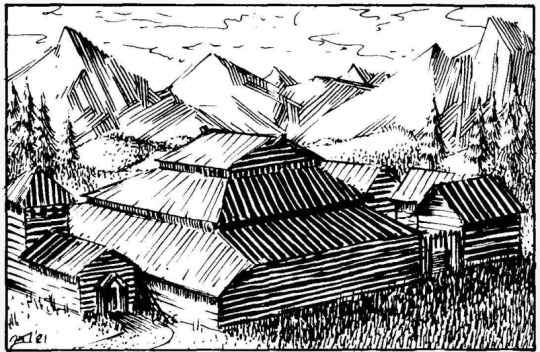
Not a huge deal but, a kind of weird inconsistency that top one looks like a stockade and the bottom one looks like a log cabin. Side note, we know that the long dimension of this is using 210 feet tall logs, which is to say, the size of an average redwood. These are some big fuck-off trees -- which could be a very interesting detail about the local area.
Now the setup is pretty simple. You were hired to go beat up the giants because they've been raiding the local humans, figure out why they're raiding, and comeback posthaste. The locals have kitted you out with horses, guides, maps, et c -- but no compensation, they have simply omitted a finder's fee (cheap bastards). Also, if you fail, they'll execute you. With friends like these, who needs Giants?
Gary starts with some mild railroading (you accepted the job already, you are already kitted out, you already walked to a nearby cave, you waited til dusk to approach, you notice two guards are missing, and the cave is guaranteed to be moderately hidden. Sure, whatever, I'm going to ignore that if I run this tho. Gary notifies us of a few critical details:
Don't run this stock, that's immoral
Any surviving giants will flee to G2 if they have the opportunity (which, kind of inherently punishes clever play that avoids combat?)
There is a 2% chance per round that the wooden structure will be lit on fire due to chronic rain (why is this a dice roll??)
If you will permit me a tangent, player arson is truly the bane of interesting scenarios everywhere. Whenever a player wonders, "why are all the GM's dungeons underground or in stonework buildings?", it's because doing anything else invites arson as the default and best answer to all problems. Magic items are fireproof and most metal items will not get hot enough to be destroyed, so very often the best solution is to burn the place to the ground and loot it the next day. So, yeah. No wood buildings. Gary's fix is to have all the giants flee into the basement, then waste a week of the PC's time for daring to use arson. Kind of sucks!
Tangent complete.
Here's some random interesting bits:
Gary explicitly states that you can pass yourself off as hill giant kids, which is extremely funny. Minus the implicit child murder.
Naturally there are giant moms doing giant housemaid shit in several rooms. Presumably they have giant curlers too.
The secret door is, literally just a doorway covered by a pelt. I have to hand it to them, that'd trip up most players in 2024 AND make them feel stupid for not figuring it out!
The big reveal that Eclavdra the Drow is secretly behind it all is so lightly teased that it feels downright tasteful.
A giant that uses a ballista as a crossbow (based) and spears for arrows (also based) -- between the prevalence of lightning spears and greatarrows, one starts to think of a certain famous video game. Genuinely I think it'd be a fun exercise one day, for someone who is more knowledgeable than me about Japanese fantasy roleplaying culture, to talk about how anglophone fantasy works made their way into Japan and were interpreted.
One of the cloud giants has hidden a sentient giant slaying sword that speaks all the giant languages, it feels like there's a hell of a story going on there that is only alluded to!

To my knowledge, this is the first official depiction of an orc in DND? Which implies that Gary is team pig-orcs, which is cool. Frankly, I love porcine orcs, or even better just pigfolk in general, they're great.
I think it is actually a rather bold early stance for Gary to hold that, even here in 1978, Chaotic aligned creatures are not automatically friends. Granted, that's how it is in Elric, so it's not THAT bold, but clearly everyone else missed the memo. The orcs are willing to side with you at least in the short-run, and in our previous modules it was very rare to have groups of chaotic-aligned creatures fighting one another. It was always just personal beefs. In fact, the overall theme of G1 so far is that despite the boxy-ass dungeon design, there's already a command of naturalism that even modern dungeons really struggle with. Factionalism truly is the gift that keeps on giving for the GM!
So the big reveal internally to G1 (just think of that -- a reveal internally to G1, and externally to the GDQ supermodule -- we're already getting pacing!) is that the orc slaves have rebelled. And -- hey -- good for them. There's also a kind of…built-in companion refill system going on here? So in oldish DND the way it works is, the expectation is the party is not just 5 guys with swords. You've got companions to help fight, and you've got hirelings to do other stuff (test suspected traps, if you're evil). And you can only hire so many of these guys from town, but attrition is going to happen. So the modules simply provides, automatic replacements should you negotiate worth a quarter of a shit. A dwarf slave here, an orc slave there. Maybe a giant dissenter if you're really clever. One of the potential "rewards" you can get is more dudes to throw at problems.
More interesting bits
There is, what I can only really call an abortive idea going on here where there's a scary temple in the basement? But no one worships there and no information is provided. It is merely a fucked up altar. I think I vaguely recall that it's retconned Tharizdun in one of the remakes? They always retcon things to be Tharizdun. Busy man, Tharzy.

Gary, Gary no. Stop it. Stop this 78 guys bullshit. I thought we had established that giant rooms of giant clumps of guys was bad. I know you have terminal Napoleonics brain but stop.

Wait, Steading is a noun? I always thought it was a verb. Yknow, like "Steading those hill giants", taking 'em down a notch. Apparently, a Steading is a small farm -- same etymology as Homestead. I guess mark that as our first Gygaxism?
Our second Gygaxism is gill, which is "a quarter pint of an alcoholic drink", which is to say a few mouthfuls

Always end your adventures with weird, ominous non-diegetic text. On the flip-side, absolutely do not do what the adventure does, and end on a teleporter that takes you to the next dungeon. That is the worst option.
Anyway, that's the whole Hill Giant situation. Honestly, it's better than I remembered, but in proud module tradition up to this point it gets weirdly filler-y in the basement. There's just something about basements that makes dungeon designers stop giving a shit, I swear. I do need to give the man his due, even though he was a shitass person: Gygax wrote an 11 page module that is of noticeably higher killer-to-filler ratio than any of his contemporaries. G1 is better than any of its predecessors, pound for pound. It is way, way shorter which is I suppose a plus to me and a minus to others, but -- there is a clear internal logic to this place that is tragically missing from (say) The Dwarven Glory. And that internal logic is the beginning of good adventure design. Anyway, we have two fun tidbits to discuss before we end for the day.
First up, we have an of-the-time account of events in Dragon #19! It turns out that in Origins '78 they played G1-G3's prototype. The account is of the winners (mostly West Virginians, a few Michiganders), who used their magic extremely liberally to hide what they were doing as well as to scout. They did opt to light the place on fire, good for them! If you want to check this out, it's on page 3. I will mention G2 and G3 here as relevant later.
Second up, there's a weird interquel hiding in Dungeon #198! Hanging out as an informal G1.5 is "The Warrens of the Stone Giant Thane!" I will not review it in full because my understanding of 4e is, basically just skimming the PHB and reading the DMG, but essentially the Stone Giants are hypothetically aloof and not particularly loyal to their Fire Giant superiors, but someone gave them The Rock That Makes You Crazy and so now they are. Smash the rock!

Man, map design in the 4e era was so fucking bad. It looks fine, but like, this is four circles. And downstairs is, of course, cave as far as the eye can see. Aren't stone giants supposed to be skilled carvers? Anyway, If you feel like G2 would be too big of a jump mechanically compared to G1, this exists. I'm sure you could use it if you liked, and certainly there is a Genre of Grognard who would be kinda tickled at the thought of finding "lost content" for el classico GDQ.
Next week, we cover G2, which was also in July. So was G3! They're triplets!
5 notes
·
View notes
Text
Reading-list for an “old-school D&D” fantasy
Aka, here is the list of the fantasy books that MASSIVELY influenced the original D&D and its first editions. Or, if you want to put it another way, the books that were the ingredients to create D&D/that were copied by D&D.
# J.R.R. Tolkien’s “The Lord of the Rings” (+ “The Hobbit”). The source of modern fantasy, and THE main influence and source of old-school D&D. In fact, the creation of D&D was basically the creation of “The Lord of the Rings: The Role-Playing Game”. Very famously (or unfamously), in its original edition, D&D included a LOT of elements taken from the work of Tolkien, that then had to be re-shaped due to being under the copyright of Tolkien’s work. In the first edition D&D you’ll find “hobbits”, “mithril” and “balrogs” for example - that D&D had to change to “halflings”, “mithral” and “balors” to legal reasons. The only Tolkien-specific creatures D&D could keep were the orcs. Overall a LOT of D&D comes from Tolkien: the original depictions of elves and dwarfs, the ents (sorry, treants), the wights, the symbols of the “eye of fire” and “white hand” for the gods the orcs worship... And of course, the “Ranger” class was originally just the character of Aragorn as a class.
# Poul Anderson’s “Three Hearts and Three Lions”. This book was one of the two sources for the alighnment system of D&D of “Order versus Chaos” in a fantasy world. The D&D trolls were also heavily influenced by the depiction of trolls in this novel, PLUS the “Paladin” class was influenced by the character of Holger Carlsen.
# Michael Moorcock’s “The Elric Saga”.The other main source of the “Order vs Chaos”, “Lawful vs Chaotic” alignment of D&D - but also the main inspiration behind the Drow and the D&D-shaped image of “Dark Elves” in general (in the novels, they are the Melnibonéan Empire). D&D also contains several other references to the Saga - for example “Blackrazor” is inspired by Elric’s iconic sword, “Stormbringer”.
# Robert E. Howard’s “Conan the Barbarian”. The source of heroic fantasy the same way Tolkien’s LotR was the source of epic/high fantasy - the Barbarian class of D&D (and the image of a Barbarian in fantasy in general) all comes from Conan.
# Fritz Leiber’s “Fafhrd and the Gray Mouser”. The origin of the “Sword and Sorcery” genre (at least, as called as such), originally intended as a parody of the Conan-style heroic fantasy genre, but then promptly becoming itself a serious and admired genre-creating classic, Leiber’s works were another major inspiration for D&D (the “Thief” class was heavily inspired by the character of the Gray Mouser), and there is a good number of supplements and books in D&D entirely centered around this book series - introducing the characters of the books, the gods of Newhon, or the city of Lankhmar, into the D&D world.
# Jack Vance’s “The Dying Earth” series. The magic system of D&D was heavily influenced by how Vance re-imagined magic and spells in this unique sci-fi feeling fantasy: some spells and items are directly taken from the books (the prismatic spray, the ioun stones) and the entire concept of needing to “re-learn” or “re-charge” a spell once it is cast is the Dying Earth magic system (called by some “Vancian Magic”).
# H.P. Lovecraft’s work (especially anything tied to the “Cthulhu Mythos”). Lovecraft’s brand of eldritch horror and alien fantasy has also been a big influence over the creatures and deities of early D&D - to the point that the various gods of the Cthulhu Mythos were included as one of the pantheons that could be used in the early editions of D&D (alongside other pantheons such as the gods of Newhon from Fafhrd and the Gray Mouser, or the gods of the Conan world).
# Gary Gygax, one of the creators of D&D, also listed other authors as direct influence for his game, but given I am less familiar with them I will just list them here: Fletcher Pratt (I think it might be his “Harold Shea” series, quite famous in the fantasy genre), L. Sprague de Camp, Edgar Rice Burroughs (the creator of some of the most famous American fictional characters, such as John Carter of Mars, or Tarzan) and A. Merritt.
(Finally, not a literary work, but a series of movies that also influenced early D&D: the “Sinbad” movies of the mid-20th century. If you look through the creatures, monsters and illustrations of early editions D&D you’ll find several references to movies such as “The 7th Voyage of Sinbad“ or “The Golden Voyage of Sinbad”)
#reading-list#d&d#dungeons and dragons#fantasy#old school#heroic fantasy#epic fantasy#reading list#literature#old school d&d#first edition d&d
21 notes
·
View notes
Text
Welcome to Wonderful World of Darklords, ya filthy animal! While it's not animated, Home Alone is technically Disney now that they've bought 20th Century Fox (and let's face it, we're eventually doing Hocus Pocus and Haunted Mansion, so "not animated" isn't a dealbreaker). What's more, in a world where a magical wish really can make your family disappear, Kevin is a perfect darklord trapped in a hell of his own creation--and ready to put your PCs in that hell, too. Topics discussed include:
How to get your PCs to go into Kevin's little funhouse so they get all tore up, even though they presumably won't be tempted by promises of stereos, VCRs, and toys;
Suggestions for translating Kevin's sadistic traps into their equally sadistic D&D equivalents (with some inspiration from the master of "up yours" traps, Gary Gygax);
Alternate versions of Kevin and his house with a variety of different tones, from "heartwarming holiday special about family" to "cathartic beatdown of a spoiled, hateful man-child;"
The challenges of adapting a film where the wish-fulfillment power fantasy character is the darklord and the hapless victims are the PCs;
And more!
The full writeup for the McElminster house is available for free on DM's Guild: https://www.dmsguild.com/product/461188/The-McElminster-House-A-Ravenloft-Domain-of-Dread?affiliate_id=241770
The official WotC Home Alone-inspired stream we mentioned is available here: https://www.youtube.com/watch?v=DssYPINaF9E&t=2s
Bingo cards from the inimitable @dusty-purple are available here: https://bingobaker.com/#65799823d1221317 Play along!
Book Club of Dread absolutely will not be ready December 20th (very optimistic view of your editing powers there, Past Rachel), but we're going to move heaven and earth to make sure it's out by Epiphany so the Christmas Bellringer is still appropriate. For the Christmas Bellringer, you want roughly equal parts ginger beer and orange juice OR roughly equal parts gin, ginger beer, and orange juice; adjust the proportions to taste. Please, we beg you, go slow if you add the gin. The ginger beer will hide the flavor of the gin, you will forget you aren't drinking a mocktail, and your bell will get rung if you pour yourself a big ol' glass with the intention of nursing it over a couple hours. This stuff makes Hocus Pocus Punch look like chocolate milk.
All music recordings are in the public domain (mark 1.0) and are licensed through https://musopen.org:
Chopin Nocturne in B-Flat Minor, Op. 9 No.1 (main theme), performed by Eduardo Vinuela
Chopin Etude Op. 25, No. 12 in C Minor: “Ocean” (darklord theme), performed by Edward Neeman
Chopin Nocturne in F Minor, Op. 55 No. 1 (land theme), performed by Luke Faulkner
Rachmaninoff Morceaux de Fantaisie, Op. 3 - 2. Prélude in C sharp minor (Dread Possibilities), performed by Sergei Rachmaninoff
Chopin Nocturne in E Minor, Op. 72 No. 1 (parting thoughts), performed by Luke Faulkner
Dialog for Yensid was written by Azalin Rex himself: @darklordazalin
The Wonderful World of Darklords logo was designed by Halite Jones, whom you can find @halite-jones or on Instragram at http://www.instagram.com/insta_halite
Contact us on:
Gmail: [email protected]
Facebook: @wonderfulworldofdarklords
Patreon: https://www.patreon.com/TheWonderfulWorldofDarklords651
#wonderful world of darklords#ravenloft#dnd#podcast#curse of strahd#dms guild#home alone#Christmas DnD session#a very special episode#the silver tuna
5 notes
·
View notes
Text
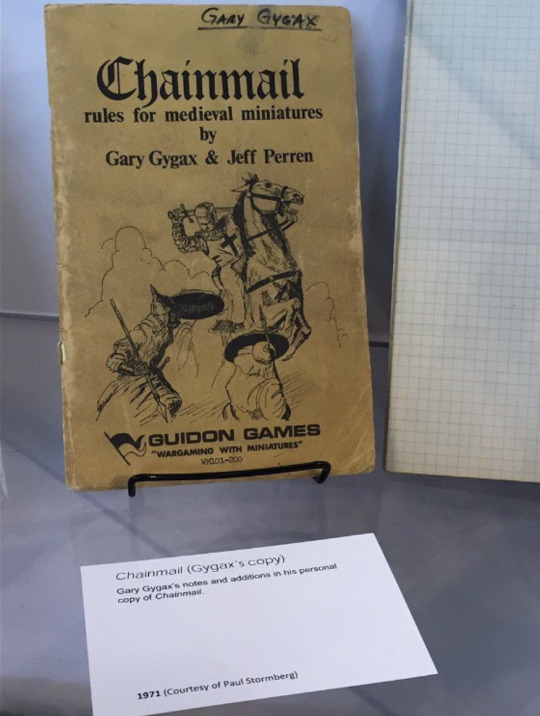

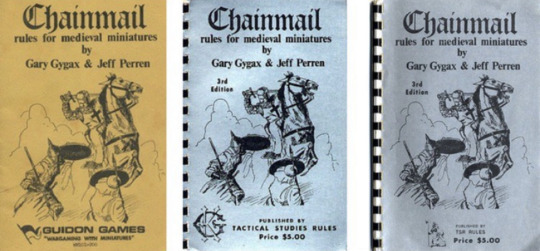
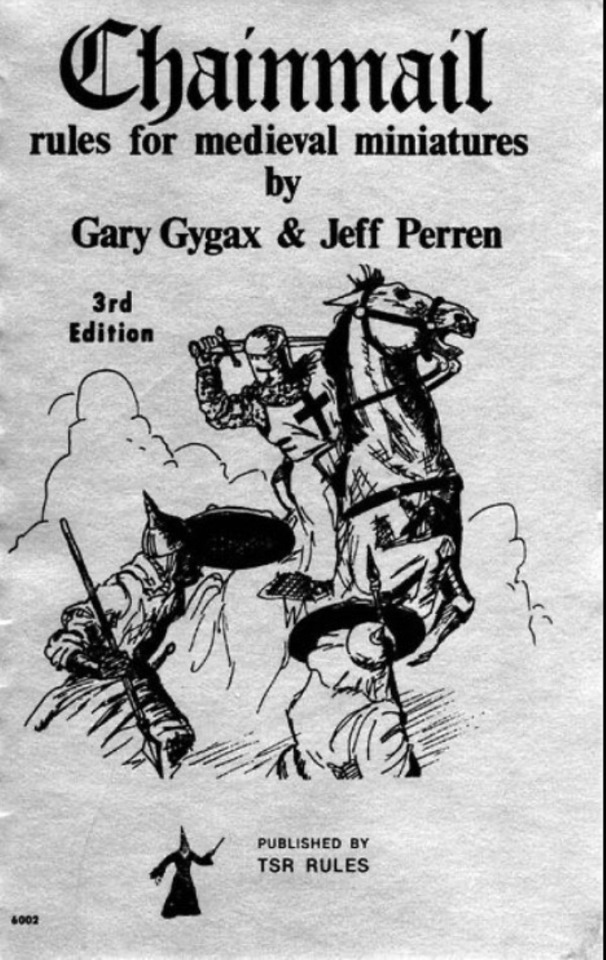


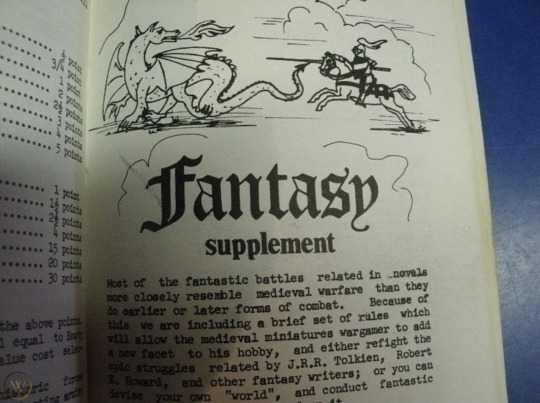
In 1971 the rules for Chainmail were released by a hobby shop owner named Jeff Perren and an avid gamer named Gary Gygax. Still a war game at its core, this set of rules contained the seeds of what would later evolve into D&D. In particular, the game introduced fantasy rules and man-to-man combat rules—both precursors to a game that would eventually focus on fantasy heroes. Interestingly, Gygax was more interested in Robert E. Howard’s gritty sword and sorcery than analog medieval settings or Tolkien-esque fantasy—but the tastes of the day won out. Chainmail is an excellent lesson in game design, because it speaks to the fact that most great developments are adjustments of tried-and-true systems. Gygax looked at the war games of his day and thought, “hey, you know what this is missing? One-on-one combat and magic!” That simple tweak set the stage for the beauty that was to follow and, as they say, the rest is history...
45 notes
·
View notes
Text

July 27 is Gary Gygax Day! • We celebrate E. Gary Gygax, co-creator of Dungeons & Dragons! Here's an image I drew last year for his birthday. I was never a heavy gamer, but I learned how to create characters, tell a story, learn about various mythology & monsters, and more; thanks to D&D. Mahalo for bringing us fellowship, adventure, fantasy, & fun!
#jonjmurakami #garygygax #egarygygax #d20 #dungeonsanddragons #garygygaxday
3 notes
·
View notes
Text
DUNGEONS & DRAGONS: HONOR AMONG THIEVES (2023) Now with 2nd trailer
Dungeons & Dragons: Honor Among Thieves is a 2023 action fantasy film about adventurers carrying out an epic heist.
Written and directed by John Francis Daley and Jonathan Goldstein (Game Night; Vacation) based on the game created by Dave Arneson and E. Gary Gygax.
The movie stars Chris Pine, Michelle Rodriguez, Regé-Jean Page, Justice Smith, Sophia Lillis, Chloe Coleman, Daisy Head and Hugh…

View On WordPress
#2023#Chris Pine#Dungeons & Dragons: Honor Among Thieves#Hugh Grant#John Francis Daley#Jonathan Goldstein#Justice Smith#Michelle Rodriguez#movie film#Regé-Jean Page#Sophia Lillis#trailer
5 notes
·
View notes
Text
O que é OSR e por onde começar
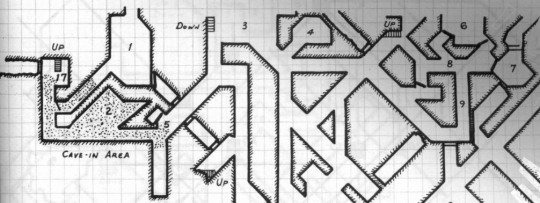
OSR (Old School Renaissance ou Old School Revival) é um movimento moderno dentro das comunidades de RPG que busca recuperar o estilo de jogo dos primeiros jogos de D&D (Dungeons & Dragons). Ele surge da busca de certas características que eram prioridade nos jogos de antigamente e que foram sendo substituídas ou obscurecidas por tendências mais atuais, de forma simular uma experiência de jogo mais próxima da originalmente projetada por Gary Gygax e Dave Arneson (criadores originais do D&D).
Exemplos das tendências desses jogos:

O movimento começou a tomar forma através do uso do OGL (Open Game License) do D&D 3e colocado pela WotC (Wizards of the Coast) que alguns autores utilizaram para publicar suas próprias revistas e livros revisitando OD&D (Original Dungeons & Dragons), que embora revolucionário, tem a escrita bem nebulosa e confusa. Aos sistemas nascidos da reescrita dos D&D clássicos é dado o nome de Retroclones.
Mais do que a reescrita das regras antigas, o movimento do OSR busca a filosofia e estilo de jogo que esses sistemas e forma com que eram escritos preconizavam.
Características do estilo
Foco em exploração e campanhas sandbox, reforçado por regras como XP por ouro conquistado, direcionando os jogadores a buscar por si mesmos os mistérios do mundo fantástico que habitam.
Foco em imersão e solução de problemas através de ideias criativas, onde o jogador que deve sugerir soluções para os desafios.
Preocupação muito menor com equilíbrio na dificuldade. É encorajado o uso de monstros e armadilhas coerentes com o ambiente, independente do nível dos jogadores, e que devem ser enfrentados de forma inteligente ou evitados.
Alta letalidade advinda da vida de aventureiro em um mundo perigoso, apoiada por sistemas de criação de personagens agilizadas, fichas mais coesas e com menos informações.
Foco na narrativa emergente do jogo, ao invés de personagens com histórias e antecedentes completos.
Foco em homebrew, adaptação de regras e desconstrução de sistemas e ambientações. O cenário OSR cresceu a partir de jogadores e escritores que decidiram ser autores de uma nova linha de jogos paralela ao crescimento dos jogos de D&D moderno (D&D 3e em diante). É como se tivessem pegado OD&D e AD&D (Advanced Dungeons & Dragons) e feito suas próprias continuações. Os próprios sistemas de OSR são escritos esperando que os jogadores adicionem suas próprias regras e conteúdos
Por onde começar
Se essa forma de se jogar parece interessante para você, pode buscar alguns dos seguintes jogos gratuitos:
Basic Fantasy RPG: adaptação open source com anos de conteúdo desenvolvido por uma crescente comunidade.
Delving Deeper: retroclone de Chainmail (conhecido como 0e ou Edição Original) de 1974, que reorganiza e emula o sistema que viria a se tornar base da primeira edição de D&D.
For Gold & Glory: Retroclone de D&D 2e, com toda sua complexidade e riqueza em tabelas e customização reescrita.
Mausritter: OSR com regras mais leves e livro menor, com muitas ferramentas para homebrew.
#rpg#D&D#OD&D#ttrpg#pt-br#OSR#Old school#introdução#AD&D#Basic Fantasy#Delving Deeper#mausritter#knave
1 note
·
View note
Text

Uso de RPG na psicologia atrai o interesse de crianças e adolescentes
Acesse em https://aredacao.com.br/vida-e-saude/192293/uso-de-rpg-na-psicologia-atrai-o-interesse-de-criancas-e-adolescentes
RPGs, ou Role-Playing Games (Jogos de Interpretação de Personagens, em português), são um gênero de jogos em que os participantes assumem papéis de personagens fictícios em um cenário imaginário ou baseado em uma narrativa pré-estabelecida. Nesses jogos, os jogadores dão vida aos personagens, tomando decisões que afetam o desenvolvimento da história. Embora o conceito de interpretar personagens possa ser rastreado até a Antiguidade, o que conhecemos como RPG hoje surgiu em 1974 com "Dungeons & Dragons" (D&D), criado por Gary Gygax e Dave Arneson. D&D foi fortemente influenciado por jogos de guerra e histórias de fantasia, como O Senhor dos Anéis, de J.R.R. Tolkien.
Para além das mesas entre amigos e familiares, o RPG tem sido usado como uma ferramenta terapêutica na Psicologia e em outros campos relacionados à saúde mental. O RPG terapêutico envolve a utilização dos elementos do jogo para ajudar os pacientes a lidarem com questões emocionais, desenvolver habilidades sociais, melhorar a autoestima e explorar e resolver problemas pessoais. É importante ressaltar que o RPG terapêutico é conduzido de forma diferente do RPG de entretenimento tradicional. O foco principal não é apenas no jogo em si, mas na experiência terapêutica que ele proporciona.
Os psicólogos Sérgio França e Bruno Pontes são dois dos sócios de uma clínica em Goiânia que adotou o RPG como ferramenta para a terapia de grupo para o público infanto-juvenil. Os dois se conheceram na faculdade, em um laboratório de pesquisa de analistas do comportamento, e ambos já conheciam e jogavam RPG. A aplicação é feita em intervenções de grupo por meio da análise do comportamento aplicada, atendendo principalmente crianças e adolescentes com transtorno do espectro autista (TEA) e com Transtorno do déficit de atenção com hiperatividade (TDAH).
Os profissionais atendem atualmente cerca de 20 pacientes divididos em diversos grupos. “O RPG chama muito a atenção porque suas qualidades terapêuticas são quase evidentes: muita comunicação, interação, requer o desenvolvimento de habilidades sociais. Nenhuma simulação e outros estilos de jogos lidam com interação social do mesmo jeito”, avalia Bruno Pontes.
“O centro das nossas intervenções é a motivação. Vamos utilizar dessa empolgação que os jogadores têm para que a aprendizagem ocorra de forma mais fácil, fluida e permanente. Passamos, então, a adaptar e desenvolver sistemas com foco no desenvolvimento dos objetivos terapêuticos”, relata Sérgio França. Para isso, os dois psicólogos utilizam cenários e formatos baseados em D&D e Pathfinder: fantasia heroica em que os jogadores derrotam dragões, salvam reinos e obtêm tesouros. Para jogar, basta ter dados, papel e caneta: os jogadores fazem de conta e rolam os dados para superar desafios.
Esta perspectiva atrai o interesse dos jogadores, porém o sistema é severamente modificado para que possa atender às demandas de cada um para atingir os objetivos terapêuticos de forma gamificada. Inicialmente, é feita uma entrevista com os pais e, a partir disso, são iniciadas terapias individuais por alguns meses para que sejam observadas as habilidades e necessidades dos pacientes, que mais tarde serão inseridos em grupos com jogadores com os mesmos interesses e idades.
Os 'RPGs heroicos' costumam ter muito foco na ação e no combate. Na versão adaptada de Bruno e Sérgio, são as interações que viram o foco. “As sessões ainda vão ter momentos de combate, mas em uma escala muito menor. As narrativas vão levar os jogadores a necessariamente buscarem resoluções mais pacíficas, envolvendo interações sociais e comunicação. Aí, quando eles se saem bem nesse engajamento, eles são recompensados dentro do jogo, validando aquela ação”, explica Bruno.
Dessa forma, os momentos de combate e ação acabam sendo mais como recompensas, e não desafios: resultado de terem conquistado o verdadeiro objetivo de alcançar as resoluções terapêuticas dentro do cenário apresentado.
Interesse renovado e perspectiva acadêmica
A psicóloga Lenita Lencioni faz atualmente uma especialização em teoria cognitiva-comportamental pela Pontifícia Universidade Católica do Rio Grande do Sul (PUC-RS) com o objetivo de dar continuidade ao mestrado e doutorado. Sobre o RPG, ela garante que os resultados são satisfatórios quando o assunto envolve saúde mental e interações. “O RPG sempre fez parte da minha vida, desde os 12 anos de idade, e sempre gostei bastante, sempre foi uma experiência muito importante e que me ajudou a me desenvolver socialmente, a ser uma pessoa mais cooperativa. Você percebe os frutos quando adulto: a importância de perseverar, de ter objetivos, e meu objetivo é poder compartilhar isso com as pessoas e permitir que crianças e adolescentes possam ter esse desenvolvimento da mesma forma que foi pra mim: aprendendo e me divertindo”, relata.
Lenita segue pesquisando alguns artigos que falam da relação desse mundo com a psicologia, mas o que ela mais conhece até agora é experienciado e aplicado. “Eu utilizo o RPG na terapia, na abordagem cognitiva-comportamental, como uma técnica de ludoterapia, que é psicoterapia voltada para o tratamento psicológico de crianças, e quero consolidar essa maneira de atender de forma científica e teórica. As pesquisas ainda são muito frescas e recentes”, conta. No momento, ela utiliza em sua prática clínica o sistema Hero Kids, um jogo de RPG voltado especificamente para crianças.
De fato, apesar de o RPG ser estudado academicamente de alguma forma desde o começo dos anos 1990, os artigos e pesquisas ainda são dispersos, atomizados em diferentes áreas, recortes e com lacunas de tempo entre eles. Um novo interesse surgiu no Brasil e no exterior desde meados dos anos 2010, mas ainda está distante de ter um corpo vasto.
“Talvez existia uma resistência por parte da academia em relação ao tema, a gente sabe que por muito tempo houve um preconceito grande com esses jogos, mas, percebendo a necessidade de diminuir a exposição das crianças ao meio eletrônico, e por estar se tornando muito popular, acho que é um momento de grande abertura em relação a isso”, avalia Lenita. “O que ainda impede um pouco é o fato de as pessoas não conhecerem e não saberem como funciona, mas ainda assim vejo que muita gente tem curiosidade e vontade de conhecer e jogar, mas há uma escassez de narradores de jogo e de mesas, o que impede uma adesão de mais pessoas”, completa.
Na sua experiência, inclusive, Lenita relata que o jogo tem uma alta capacidade de engajamento, o suficiente para que os jovens esqueçam das redes sociais. “Quando a gente tem uma narrativa bem consolidada e um jogo envolvente, que flui, ninguém pega no celular. Através da ludoterapia, eu tenho uma gama de ferramentas para usar. Podemos desenvolver algumas técnicas para abordar demandas específicas de cada paciente, em um mundo que o paciente tem afinidade e com o qual ele vai se engajar, criando um espaço seguro por meio da narrativa”, conclui.
Os psicólogos Sérgio e Bruno relatam que também querem buscar levar o tema para o mestrado e doutorado. Enquanto isso, buscam encontrar melhores metodologias e formas para coletar e registrar dados. Segundo Sérgio, ter um respaldo acadêmico irá conferir solidez ao tema e à abordagem, além de silenciar possíveis críticas. “Quando a gente tem, de fato, um método de pesquisa com resultados objetivos e quantificados e isso é apresentado em forma de artigo e validado pela comunidade, isso melhora nossa prática como terapeutas para observar quais são os melhores caminhos para que tenhamos os melhores resultados possíveis”, explica. “E isso gera modelos que podem ser aplicados e replicados pela comunidade”, completa Bruno.
Influências
Como dito por Lenita, o RPG atualmente passa por um momento de redescoberta e popularidade. Esse renascimento tem a ver com alguns fenômenos de cultura pop. O principal é Stranger Things, da Netflix. No seriado, os personagens não apenas jogam D&D como usam o cenário para nomear e interpretar os acontecimentos e aventuras da própria série.
Outro fenômeno, mais restrito aos adolescentes, é A Ordem Paranormal, uma websérie brasileira criada pelo streamer Rafael "Cellbit" Lange e dirigida por Júlio Taubkin, na qual uma equipe de influenciadores joga RPG de mesa em um sistema e cenário criados por ele. O show começou a ser transmitido em 29 de fevereiro de 2020 pelo canal da Twitch de Cellbit e atrai centenas de milhares de fãs.
E a prática tem gerado resultados. “Em poucos meses, as famílias elogiaram muito e notaram mudanças no comportamento dos filhos nas interações com os pais, com os colegas. Eles estavam fazendo interações mais assertivas”, conta o psicólogo Bruno. “Tivemos um aumento muito grande no relato de evolução. Como as mudanças ocorrem mais rápido, os familiares percebem com mais facilidade, justamente por causa deste engajamento: os jogadores saem da sessão comentando, falando de suas experiências”, pontua.
Sérgio salienta que, na visão dele, o ponto mais forte da abordagem com o RPG é o engajamento criado pelo formato, capaz de gerar efeitos duradouros. “Muitos pacientes chegam falando pra gente que querem muito ter amigos, mas que têm muitas dificuldades na escola e que se sentem muito só. Ouvimos este tipo de relato com frequência. Então eles encontram aqui um ambiente validante em que engajam em uma atividade divertida que desenvolve novas habilidades e cria novos vínculos”, finaliza ao destacar que é crescente a procura pelo método.
0 notes
Text
370. Various Authors - Dragon #95 (March 1985)

This might not have the most famous or best cover of all Dragon magazines and that might lead you to think that it's just one more issue like all the others. However, you couldn't have been more wrong. With half a dozen good articles and features for D&D and AD&D, this also has two items of historical importance.

First among these is a column by Gary Gygax which I have seen quoted again and again, and it's the one about the relative influence of Tolkien in the development of (A)D&D, a kind of a biographical article, it contends that Tolkien's influence was extremely limited, giving credit instead to the American pulp writers which helped found the Sword and Sorcery genre like Robert E. Howard and those who followed in his footsteps, such as Fritz Leiber and L. Sprague de Camp, as well as other pulpy authors such as Lovecraft. Gygax even credits other British writers such as Michael Moorcock above Tolkien, which he frankly finds to be "boring".

The other important entry in this issue is the first ever published adventure module set in The Forgotten Realms, entitled "Into the Forgotten Realms'', it's a short competition adventure module by Ed Greenwood, set in the Dales as your party goes from Shadowdale to the lost elven city of Myth Drannor attempting to recover or destroy magical artifacts before the evil ruler of Scardale, Lashan, manages to obtain them. Other than this there are plenty of articles on subjects such as raising levels for demihumans by Gygax (another momentous article), the ecology of the cockatrice by Greenwood, ape stat blocks for the game, tactics for wilderness combat, distribution of XP and so forth. Brimming with content this one.
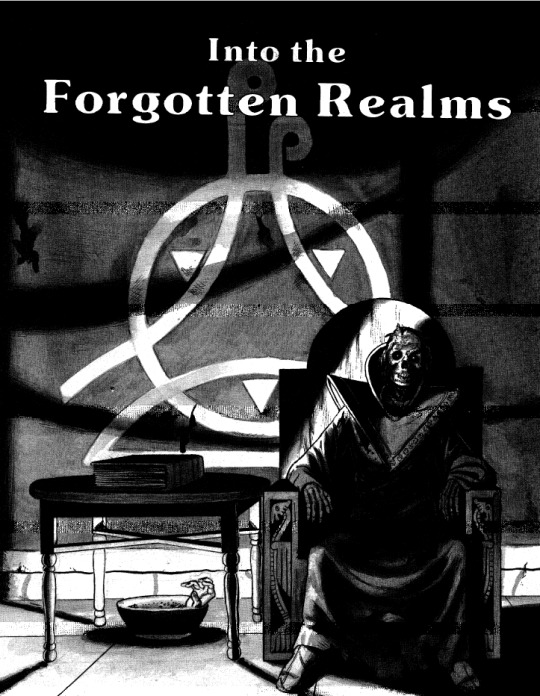
#adnd#dnd#ttrpg#ad&d#d&d#dnd art#dungeons and dragons#dungeons & dragons#forgotten realms#gary gygax
9 notes
·
View notes
Photo
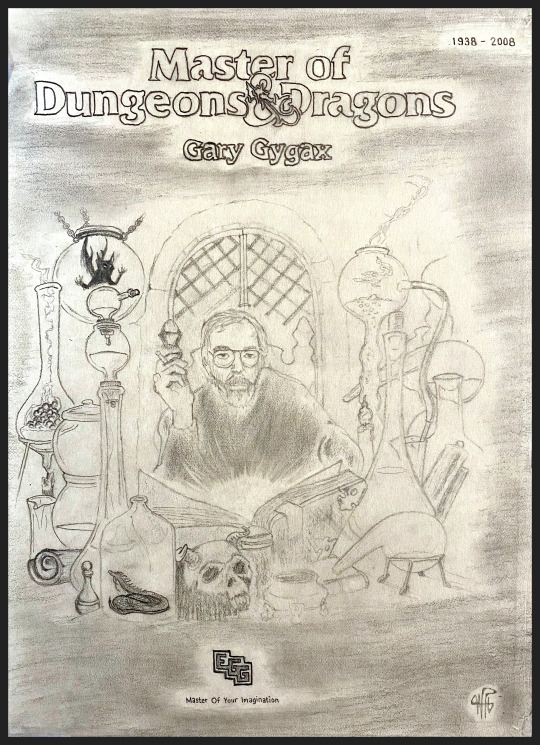
Today marks the 15th year since the passing of E. Gary Gygax, without whom, Dungeons & Dragons would not exist. I made a drawing in honor of him, based on 1985’s Unearthed Arcana book cover. Here’s to EGG!
1 note
·
View note
Text
Dungeon & Dragons, ecco il trailer del film in uscita nel 2023, L'onore dei Ladri
Dungeon & Dragons, ecco il trailer del film in uscita nel 2023, L’onore dei Ladri
Un antipasto di due minuti.
Paramount Pictures ha pubblicato il primo trailer di Dungeons & Dragons: L’onore dei Ladri, film basato sul celebre gioco di ruolo fantasy ideato da Gary Gygax nel lontano 1974. Che da D&D sarebbe stato derivato un film è noto ormai dal 2020, e adesso, quando al suo debutto manca meno di un anno, è giunto il momento di dare un’occhiata al trailer.
La clip da due…
View On WordPress
0 notes
